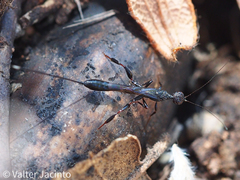Great capricorn beetle
Cerambyx cerdo
The Cerambyx cerdo, commonly known as the Great Capricorn Beetle, is an impressive species of longhorn beetle found in the Comunidad Valenciana and other parts of Europe. This beetle belongs to the Insecta class and the Cerambycidae family.
Characteristics:
- It is one of the largest beetles in Europe, with adults reaching lengths of up to 55 mm or more.
- The body of the Cerambyx cerdo is black with a glossy sheen, while the antennae can be almost twice the length of its body in males.
- These beetles are noted for their strong mandibles and distinctive, elongated bodies.
Habitat:
- The Cerambyx cerdo predominantly inhabits deciduous forests and woodlands.
- It favours warm environments and is often found in oak trees, where the larvae develop within the wood.
- In the Comunidad Valenciana, its presence can be a significant indicator of old-growth woodland ecosystems.
Life Cycle:
- The life cycle of the beetle is relatively long, with the larval development phase lasting several years.
- Larvae burrow into dead or dying wood, making them crucial for the decomposition process in forest ecosystems.
- Adults emerge in the warmer months of the year, particularly from June to August, when they can be observed on trees under sunny conditions.
Conservation Status:
- The Cerambyx cerdo is considered a species of conservation concern due to habitat loss across its range.
- Efforts are ongoing to protect its habitats, ensuring the survival of this charismatic and ecologically important insect.
This beetle is not only a critical part of the Comunidad Valenciana's biodiversity but also serves as an ambassador for conservation efforts in local ecosystems.







